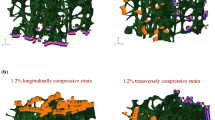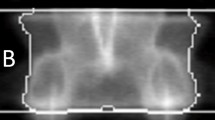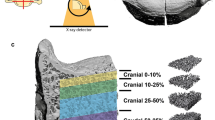Abstract
The objective of this study was to study the age-related adaptation of lumbar vertebral trabecular bone at the apparent level, as well as the tissue level in three orthogonal directions. Ninety trabecular specimens were obtained from six normal L4 vertebral bodies of six male cadavers in two age groups, three aged 62 years and three aged 69 years, and were scanned using a high-resolution micro-computed tomography (micro-CT) system, then converted to micro-finite element models to do micro-finite element analyses. The relationship between apparent stiffness and bone volume fraction, and the tissue level von Mises stress distribution for each trabecular specimen when compressed separately in the longitudinal direction, medial–lateral and anterior–posterior directions (transverse directions) were derived and compared between two age groups. The results showed that at the apparent level, trabecular bones from 69-year group had stiffer bone structure relative to their volume fractions in all three directions, and in both age groups, changes in bone volume fraction could explain more variations in apparent stiffness in the longitudinal direction than the transverse directions; at the tissue level, aging had little effect on the tissue von Mises stress distributions for the compressions in all the three directions. The novelty of the present study was that it provided quantitative assessments on the age and direction-related adaptation of Chinese male lumbar vertebral trabecular bone from two different levels: stiffness at the apparent level and stress distribution at the tissue level. It may help to understand the failure mechanisms and fracture risks of vertebral body associated with aging and direction for the prevention of fracture risks in elder individuals.
Similar content being viewed by others
References
NIH Consensus Development Conference: Osteoporosis prevention, diagnosis, and therapy. NIH Consens. State. 17, 1–45 (2000)
Melton L.J., Chrischilles E.A., Cooper C. et al.: Perspective: how many women have osteoporosis?. J Bone Miner. Res. 7, 1005–1010 (1992)
Keaveny T.M., Morgan E.F., Niebur G.L. et al.: Biomechanics of trabecular bone. Ann. Rev. Biomed. Eng. 3, 307–333 (2001)
Simpson E.K., Parkinson I.H., Manthey B. et al.: Intervertebral disc disorganization is related to trabecular bone architecture in the lumbar spine. J. Bone Miner. Res. 16, 681–687 (2001)
Keller T.S., Hansson T.H., Abram A.C. et al.: Regional variations in the compressive properties of lumbar vertebral trabeculae—effects of disc degeneration. Spine 14, 1012–1019 (1989)
Gong H., Zhang M., Yeung H.Y. et al.: Regional variations in microstructural properties of vertebral trabeculae with ageing. J. Bone Miner. Metab. 23(2), 174–180 (2005)
Gong H., Zhang M., Qin L. et al.: Regional variations in the apparent and tissue-level mechanical parameters of vertebral trabecular bone with aging using micro-finite element analysis. Ann. Biomed. Eng. 35(9), 1622–1631 (2007)
Goulet R.W., Goldstein S.A., Ciarelli M.J. et al.: The relationship between the structural and orthogonal compressive properties of trabecular bone. J. Biomech. 27, 375–389 (1994)
Keaveny T.M., Wachtel E.F., Ford C.M. et al.: Differences between the tensile and compressive strengths of bovine tibial trabecular bone depend on modulus. J. Biomech. 27, 1137–1146 (1994)
Weinans H.: Is osteoporosis a matter of over-adaptation? Technol. Health Care 6, 299–306 (1998)
Hernandez C.J., Keaveny T.M.: A biomechanical perspective on bone quality. Bone 39, 1173–1181 (2006)
Guldberg R.E., Hollister S.J., Charras G.T.: The accuracy of digital image-based finite element models. J. Biomech. Eng. 120, 289–295 (1998)
Niebur G.L., Yuen J.C., Hsia A.C. et al.: Convergence behavior of high-resolution finite element models of trabecular bone. J. Biomech. Eng. 121(6), 629–635 (1999)
Muller R., van Campenhout H., van Damme B. et al.: Morphometric analysis of human bone biopsies: a quantitative structural comparison of histological sections and microcomputed tomography. Bone 23, 59–66 (1998)
Judex S., Boyd S., Qin Y.X. et al.: Adaptations of trabecular bone to low magnitude vibrations result in more uniform stress and strain under load. Ann. Biomed. Eng. 31, 12–20 (2003)
Morgan E.F., Bayraktar H.H., Keaveny T.M.: Trabecular bone modulus–density relationships depend on anatomic site. J. Biomech. 36, 897–904 (2003)
Rho J.Y., Ashman R.B., Turner C.H.: Young’s modulus of trabecular and cortical bone material: ultrasonic and microtensile measurements. J. Biomech. 26, 111–119 (1993)
Rho J.Y., Tsui T.Y., Pharr G.M.: Elastic properties of human cortical and trabecular lamellar bone measured by nanoindentation. Biomaterials 18, 1325–1330 (1997)
Van Rietbergen B., Kabel J., Odgaard A. et al.: Determination of trabecular bone tissue elastic properties by comparison of experimental and finite element results. In: Sol, H., Oomens, C.W.J. (eds) Material Identification Using Mixed Numerical Experimental Methods, pp. 183–192. Kluwer, The Netherlands (1997)
Homminga J., McCreadie B.R., Ciarelli T.E. et al.: Cancellous bone mechanical properties from normals and patients with hip fractures differ on the structural level, not on the bone hard tissue level. Bone 30, 759–764 (2002)
Kabel J., Odgaard A., van Rietbergen B. et al.: Connectivity and the elastic properties of cancellous bone. Bone 24(2), 115–120 (1999)
Van Rietbergen B., Weinans H., Huiskes R. et al.: A new method to determine trabecular bone elastic properties and loading using micromechanical finite-element models. J. Biomech. 28, 69–81 (1995)
Ding M., Odgaard A., Danielsen C.C. et al.: Mutual associations among microstructural, physical and mechanical properties of human cancellous bone. J. Bone Joint Surg. 84-B, 900–907 (2002)
Kabel J., van Rietbergen B., Odgaard A. et al.: Constitutive relationships of fabric, density, and elastic properties in cancellous bone architecture. Bone 25, 481–486 (1999)
Homminga J., McCreadie B.R., Weinans H. et al.: The dependence of the elastic properties of osteoporotic cancellous bone on volume fraction and fabric. J. Biomech. 36, 1461–1467 (2003)
Rubin C., Turner A.S., Bain S. et al.: Anabolism: low mechanical signals strengthen long bones. Nature 412, 603–604 (2001)
Rubin C., Turner A.S., Muller R. et al.: Quantity and quality of trabecular bone in the femur are enhanced by a strongly anabolic, non-invasive mechanical intervention. J. Bone Miner. Res. 17(2), 349–357 (2002)
Van Rietbergen B.: Micro-FE analyses of bone: state of the art. Adv. Exp. Med. Biol. 496, 21–30 (2001)
Author information
Authors and Affiliations
Corresponding author
Additional information
The project supported by the Hong Kong Polytechnic University Research Grants (G-U273) and the National Natural Science Foundation of China (10502021 and 10529202).
Rights and permissions
About this article
Cite this article
Gong, H., Fan, Y., Zhang, M. et al. Age- and direction-related adaptations of lumbar vertebral trabecular bone with respect to apparent stiffness and tissue level stress distribution. Acta Mech Sin 25, 121–129 (2009). https://doi.org/10.1007/s10409-008-0198-2
Received:
Revised:
Accepted:
Published:
Issue Date:
DOI: https://doi.org/10.1007/s10409-008-0198-2




